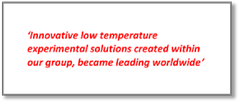 Quantum dots are promising to host spin quantum bits (qubits) for future quantum information processing. In the quest for future quantum CMOS technology, Filipp Müller strongly believes the results obtained in his thesis work will prove to be essential. ‘We demonstrated the realization of a gate-defined quantum dot structure, which is fully operational in both the electron and hole regime,’ he says.
Quantum dots are promising to host spin quantum bits (qubits) for future quantum information processing. In the quest for future quantum CMOS technology, Filipp Müller strongly believes the results obtained in his thesis work will prove to be essential. ‘We demonstrated the realization of a gate-defined quantum dot structure, which is fully operational in both the electron and hole regime,’ he says.
Working on the next generation quantum information processing, various lines of research are set out all around the world. Within the group Nanoelectronics, led by professor Wilfried van der Wiel, Filipp Müller aims at exploiting the advantages of fabrication processes already common in using silicon as a material and its electronic properties.
Besides the available infrastructure, other beneficial features might prove valuable in future, he explains. ‘In contrast to many other semiconductors, silicon can be purified to a great extent, making the spin of the nucleus controllable, not interfering with the electron spins carrying the information with them,’ he says. Compared to other semiconductor materials silicon provides an environment to control spins with minimal decoherence. So far, most experiments have focused on electrons. But the hole spin can be used as qubit as well.
MOSFET

The processes involved in fabricating qubit devices, require the use of the cleanest part of the cleanroom, in order to pattern the required nanostructures in the MOSFET-based devices: metal-oxide-semiconductor field-effect transistors. ‘Our experimental ambitions were ultrahigh, as we strived to combine electron and hole spin features within one and the same qubit device,’ Filip says.
‘Fabricating these structures was very demanding as many successive high precision steps were involved. It took many efforts before being able to characterize our results, showing we could deliver reproducible structures. These moments I shared with my promoter and all the other staff members and cleanroom experts involved. The working atmosphere was stunning. I cherish the social contacts we had all the way through the project.’
Ambipolar

The ambipolar devices may serve as an important research tool in the near future, Filipp is sure of. The strength is the ability to compare electron and hole properties in the same electrostatically defined nanostructure and thus in exactly the same crystalline environment, including defects, impurities, trapped charges and Si/SiO2 interface. ‘The future dream is that quantum computing devices are able to effectively use a continuum of spins, not only the up and down states. A lot of research still needs to be done. As a matter of fact, present day computer systems also needed decades to evolve from idea towards mass production.’
Low temperatures
Except for fabrication, also low-temperature measurement setups were demanding in this line of research. Now seven researchers within the Nanoelectronics group are involved, Filipp being the one of the pioneers.
Low temperatures are required in order to resolve the discrete energy spectrum of a quantum dot via electrical transport spectroscopy. The thermal energy has to be lower than the energy scale of the quantum dot system. In this work a dilution refrigerator was used to reach temperatures as low as 10 mK.
Filipp: ‘Innovative low temperature experimental solutions created within our group, became leading worldwide. For example the filters we worked on, and published about in a renowned magazine, was rewarded widely and attracted lots of attention. We were positively surprised, showing we are well on track.’
